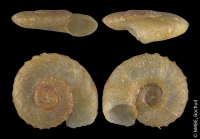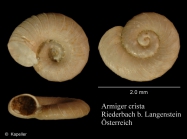MolluscaBase taxon details
Armiger Hartmann, 1843
820638 (urn:lsid:marinespecies.org:taxname:820638)
accepted
Genus
Planorbis cristatus Draparnaud, 1805 accepted as Armiger crista (Linnaeus, 1758) (type by monotypy)
Gyraulus (Armiger) W. Hartmann, 1843 · unaccepted
Planorbis (Armiger) W. Hartmann, 1843 · unaccepted > superseded combination
- Species Armiger ambiguus Popova, 1981 †
- Species Armiger annandalei (Germain, 1918)
- Species Armiger crista (Linnaeus, 1758)
- Species Armiger cristaeformis Gozhik & Prysjazhnjuk, 1978 †
- Species Armiger decorus Roshka, 1973 †
- Species Armiger geniculatus (F. Sandberger, 1872) †
- Species Armiger khoresmicus Prozorova & Starobogatov, 1996
- Species Armiger lenapalus (Bourguignat, 1881) †
- Species Armiger lluecai (Royo Gómez, 1922) †
- Species Armiger nautiliformis Gozhik & Prysjazhnjuk, 1978 †
- Species Armiger planoconvexus Popova & Starobogatov, 1970 †
- Species Armiger schamaricus Izzatullaev, 1972
- Species Armiger subcostatus Yen, 1946 †
- Species Armiger subptychophorus (Halaváts, 1902) †
- Species Armiger tshuicus Popova & Starobogatov, 1970 †
- Subgenus Armiger (Baicaloarmiger) B. Dybowski & Grochmalicki, 1920 accepted as Choanomphalus Gerstfeldt, 1859
- Species Armiger exigua A. B. Leonard, 1972 accepted as Armiger crista (Linnaeus, 1758) (unaccepted > junior subjective synonym)
- Species Armiger gracilis Gozhik & Prysjazhnjuk, 1978 † accepted as Gyraulus gracilis (Gozhik & Prysjazhnjuk, 1978) † (unaccepted > superseded combination)
- Species Armiger bakeri Prozorova & Starobogatov, 1996 (uncertain > taxon inquirendum)
- Species Armiger bielzi (Kimakowicz, 1884) (uncertain > taxon inquirendum)
- Species Armiger eurasiaticus Prozorova & Starobogatov, 1996 (uncertain > taxon inquirendum)
- Species Armiger jankowskajae Izzatullaev, 1984 (uncertain > unassessed)
recent + fossil
masculine
Hartmann, J. D. W. (1840-1844). Erd- und Süsswasser-Gasteropoden der Schweiz. Mit Zugabe einiger merkwürdigen exotischen Arten. i-xx, 1-36, pl. 1-2 [30-06-1840]; 37-116, pl. 13-36 [1841]; 117-156, pl. 37-60 [1842]; 157-204, pl. 61-72 [1843]; 205-227, pl. 73-84 [1844]. St. Gallen., available online at https://biodiversitylibrary.org/page/15269077
page(s): heft 7: 172 [details]
page(s): heft 7: 172 [details]
Taxonomy Most recent authors consider this taxon as a subgenus of Gyraulus (but see Starobogatov et al., 2004; Vinarski & Kantor, 2016)....
Taxonomy Most recent authors consider this taxon as a subgenus of Gyraulus (but see Starobogatov et al., 2004; Vinarski & Kantor, 2016). However, the molecular data provided by Saito et al. (2018) has shown it should be ranked as a genus of its own [details]
MolluscaBase eds. (2021). MolluscaBase. Armiger Hartmann, 1843. Accessed at: https://www.molluscabase.org/aphia.php?p=taxdetails&id=820638 on 2025-07-17
Date
action
by
![]() The webpage text is licensed under a Creative Commons
Attribution 4.0 License
The webpage text is licensed under a Creative Commons
Attribution 4.0 License
original description
Hartmann, J. D. W. (1840-1844). Erd- und Süsswasser-Gasteropoden der Schweiz. Mit Zugabe einiger merkwürdigen exotischen Arten. i-xx, 1-36, pl. 1-2 [30-06-1840]; 37-116, pl. 13-36 [1841]; 117-156, pl. 37-60 [1842]; 157-204, pl. 61-72 [1843]; 205-227, pl. 73-84 [1844]. St. Gallen., available online at https://biodiversitylibrary.org/page/15269077
page(s): heft 7: 172 [details]
basis of record Vinarski, M. V.; Kantor, Yu. I. (2016). Analytical catalogue of fresh and brackish water molluscs of Russia and adjacent countries. A. N. Severtsov Institute of Ecology and Evolution of Russian Academy of Science, Moscow, 544 pp.
page(s): 358 [details] Available for editors [request]
[request]
page(s): heft 7: 172 [details]
basis of record Vinarski, M. V.; Kantor, Yu. I. (2016). Analytical catalogue of fresh and brackish water molluscs of Russia and adjacent countries. A. N. Severtsov Institute of Ecology and Evolution of Russian Academy of Science, Moscow, 544 pp.
page(s): 358 [details] Available for editors
From editor or global species database
Taxonomy Most recent authors consider this taxon as a subgenus of Gyraulus (but see Starobogatov et al., 2004; Vinarski & Kantor, 2016). However, the molecular data provided by Saito et al. (2018) has shown it should be ranked as a genus of its own [details]




